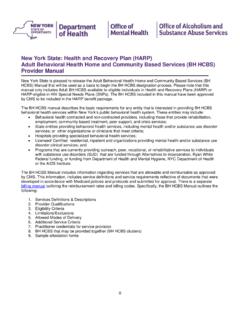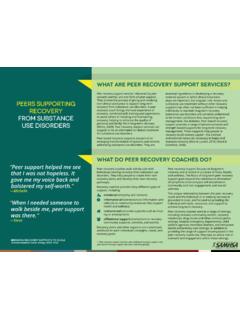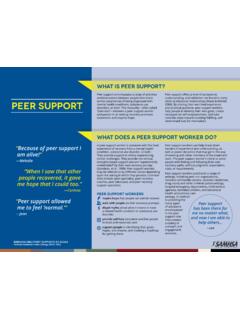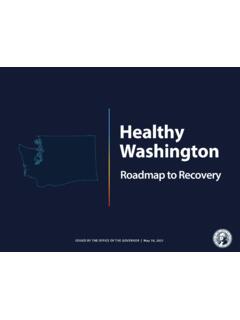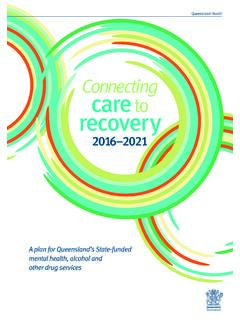Transcription of New York State Health and Recovery Plan (HARP ...
1 New York State Health and Recovery plan (HARP) / mainstream behavioral Health billing and Coding Manual For Individuals Enrolled in mainstream Medicaid Managed Care Plans And HARPS Contents Managed Care Contracting Requirements .. 3 Government Rates .. 3 Claims .. 5 Claims Coding Crosswalks .. 5 Provider Assistance Including Release / Access to plan Contract Information .. 6 Ambulatory behavioral Health Services .. 7 Assertive Community Treatment (ACT): .. 7 Clinic (OMH-Licensed Clinic, OASAS-Certified Clinic, OASAS-Certified Opiate Treatment Clinic, and OASAS Certified Outpatient Rehabilitation): .. 7 Continuing Day Treatment (CDT): .. 8 Comprehensive Psychiatric Emergency Program (CPEP): .. 9 Intensive Psychiatric Rehabilitation Treatment (IPRT): .. 12 Partial Hospitalization: .. 12 Personalized Recovery Oriented Services (PROS): .. 12 Transportation: .. 16 HARP Home and Community based Services (HCBS).
2 17 Psychosocial Rehabilitation (PSR): .. 17 Community Psychiatric Support and Treatment (CPST): .. 18 Habilitation/Residential Support Services: .. 18 Family Support and Training (FST): .. 19 Short-Term Crisis Respite: .. 19 Intensive Crisis Respite: .. 19 Education Support Services: .. 20 Empowerment Services Peer Supports (OMH): .. 20 Pre-Vocational Services: .. 20 Transitional Employment: .. 20 Intensive Supported Employment (ISE): .. 20 Ongoing Supported Employment: .. 20 Staff Transportation: .. 21 OMH 1115 Waiver Demonstration Programs .. 21 May 18, 2017 OMH/OASAS behavioral Health billing Manual for Medicaid Managed Care Plans and HARPS Page 2 New York State Office of Alcoholism and Substance Abuse Services (OASAS) Substance Use Disorder (SUD) Services and billing .. 23 Manual Purpose: .. 23 Section One - Part A: .. 25 Section One Part B.
3 28 Section One Part C: .. 29 Section Two: Reimbursement for SUD and Addiction 31 Table One: OASAS Outpatient Rate Codes .. 37 Table Two: Outpatient CPT / HCPCS Coding .. 38 Section Three .. 42 May 18, 2017 OMH/OASAS behavioral Health billing Manual for Medicaid Managed Care Plans and HARPS Page 3 Introduction This manual outlines the claiming requirements necessary to ensure proper behavioral Health claim submission with respect to mainstream Medicaid Managed Care Plans (MMCs) and Health and Recovery Plans (HARPs). Each behavioral Health service transitioning to the Medicaid managed care reimbursement model is covered in detail. This manual should be used in conjunction with the coding crosswalks of rate code to procedure code/modifier code combinations that have been prepared by OMH/OASAS for use by both Plans and providers. Both crosswalks are available as Excel files.
4 There is one crosswalk for the existing State plan services and another for the new Home and Community based Services (HCBS) that will be available to many HARP members. This billing manual does not apply to office- based practitioner billing . It applies only to behavioral Health services that can be billed under Medicaid fee-for-service rate codes by OMH-licensed or OASAS-certified programs and to the HCBS services that will be delivered by OMH and OASAS designated providers. Note: This manual addresses billing guidance only. It does not supersede applicable regulatory requirements or procedures for admission to a program, record keeping, initial and on-going treatment planning and reviews, etc. Those standards are in the regulations for each program. Managed Care Contracting Requirements Beginning with the start of the behavioral Health transition to Medicaid managed care in each geographic area, and for the first two years ( based on the regional carve-in/implementation schedule) following, managed care plans will be required to contract with providers that serve five or more of their enrolled individuals.
5 This requirement will help ensure that individuals already receiving behavioral Health services continue to receive the services they need without interruption. The specifics of this requirement are as follows: OMH Programs: For each OMH-licensed program type, Plans must contract with providers that serve five or more of their enrollees. OASAS Programs: Plans must contract with a provider having five or more of the plan s enrollees in any combination of Clinic, Outpatient Rehabilitation, or Opioid Treatment Programs (OTP). The plan must contract with the provider for all of the provider s program types. Plans must also contract with all OASAS-certified Opioid Treatment Programs in their service area, regardless on the number of plan enrollees serve by that OTP. Each plan has already received a list of providers that meet this contracting requirement. Any OMH/OASAS provider that believes it meets the threshold requirement with a particular plan , but who has not yet been contacted by that plan should contact OMH at (518) 474-6911 or OASAS at Government Rates New York State law currently requires that Medicaid MCOs pay the equivalent of Ambulatory Patient Group (APG) rates for OMH licensed mental Health clinics.
6 Beginning October 1, 2015 in NYC and July 1, 2016 in counties outside of NYC, Plans will be required to pay 100% of the Medicaid fee-for- May 18, 2017 OMH/OASAS behavioral Health billing Manual for Medicaid Managed Care Plans and HARPS Page 4 service (FFS) rate (aka, government rates ) for selected behavioral Health procedures (see list below) delivered to individuals enrolled in mainstream Medicaid managed care plans, HARPs, and HIV Special Needs Plans (SNPs) when the service is provided by an OASAS and OMH licensed, certified, or designated program. This requirement will remain in place for the first two years ( based on the regional carve-in/implementation schedule). For the new HCBS services, the government rate is the reimbursement listed for each program on the HCBS Fee Schedule. Government rates are required for the following four categories of services: OASAS Government Rate Services ( mainstream Managed Care, HIV-SNP, and HARP): OASAS Clinic Opiate Treatment Programs (outpatient) Outpatient Rehabilitation Part 820 OASAS per Diem Residential Addiction Treatment Services OMH Government Rate Services ( mainstream Managed Care, HIV-SNP, and HARP): Assertive Community Treatment (ACT) OMH Clinic (government rates are already mandated for Clinic continue to use existing billing procedures) Comprehensive Psychiatric Emergency Program (CPEP), including Extended Observation Beds (Note: For CPEP EOB services, Plans are required to pay only 80% of the FFS rate, as opposed to the 100% that is required for all other government rates services.)
7 All other CPEP services must be paid at 100% of FFS) Continuing Day Treatment (CDT) Intensive Psychiatric Rehabilitation Treatment (IPRT) Partial Hospitalization Personalized Recovery Oriented Services (PROS) HARP-Only Home and Community based Services (HCBS) HCBS Services Manual Psychosocial Rehabilitation (PSR) Community Psychiatric Support and Treatment (CPST) Habilitation/Residential Support Services Family Support and Training Short-term Crisis Respite Intensive Crisis Respite Education Support Services Empowerment Services Peer Supports Pre-Vocational Services Transitional Employment Intensive Supported Employment (ISE) Ongoing Supported Employment Staff Transportation Non-Medical Patient Transportation (Note: As is already the case with medical transportation, non-medical transportation will be carved out of the plan benefit, managed by a transportation manager based on the plan of Care, and paid FFS directly to the transportation provider).
8 May 18, 2017 OMH/OASAS behavioral Health billing Manual for Medicaid Managed Care Plans and HARPS Page 5 1115 Waiver Demonstration Programs ( mainstream Managed Care, HIV-SNP, and HARP) SUD Residential Treatment Per Diem (Stabilization and Rehabilitation) Crisis Intervention Service OASAS Off-site SUD Services (practitioner must work for a clinic, APG rates will apply) OMH Community Mental Health Services (Other Licensed Practitioners) (practitioner must work for a clinic, APG rates will apply) Claims Electronic claims will be submitted using the 837i (institutional) claim form. This will allow for use of rate codes which will inform the Plans as to the type of behavioral Health program submitting the claim and the service(s) being provided. Rate code will be a required input to MEDS (the Medicaid Encounter Data System) for all outpatient MH/SUD services.
9 Therefore the plan must accept rate code on all behavioral Health outpatient claims and pass that rate code to MEDS. All other services will be reported to MEDS using the definitions in the MEDS manual. Providers will enter the rate code in the header of the claim as a value code. This is done in the value code field by first typing in 24 and following that immediately with the appropriate four digit rate code. This is the standard mechanism historically and currently used in Medicaid FFS billing . This field is already used by Plans to report the weight of a low birth weight baby. NYS will give Plans a complete listing of all existing providers and the rate codes they bill under, as well as the rate amounts by MMIS provider ID and locator code and/or NPI and zip+4. This list will also be posted on the OMH and OASAS websites. billing requirements depend on the type of service provided; however, every electronic claim submitted will require at least the following: Use of the 837i claim form; Medicaid fee-for-service rate code; Valid procedure code(s); Procedure code modifiers (as needed); and Units of service.
10 Claims Coding Crosswalks Attached are crosswalks for HCBS and all other ambulatory behavioral Health services (including 1115 demo services). Also included in the crosswalk is the per diem rate / HCPCS / modifier codes for clinic services delivered in OASAS Part 820 Residential settings. Much additional OASAS information is in tabular form near the end of this manual. These crosswalks provide a link between existing FFS rate code- based billing and the unique rate code/procedure code/modifier code combinations that will be required under Medicaid managed care. Providers will use these coding May 18, 2017 OMH/OASAS behavioral Health billing Manual for Medicaid Managed Care Plans and HARPS Page 6 combinations to indicate to the plan that the claim is for a behavioral Health service provided by a behavioral Health program, and is to be paid at the government rate.

